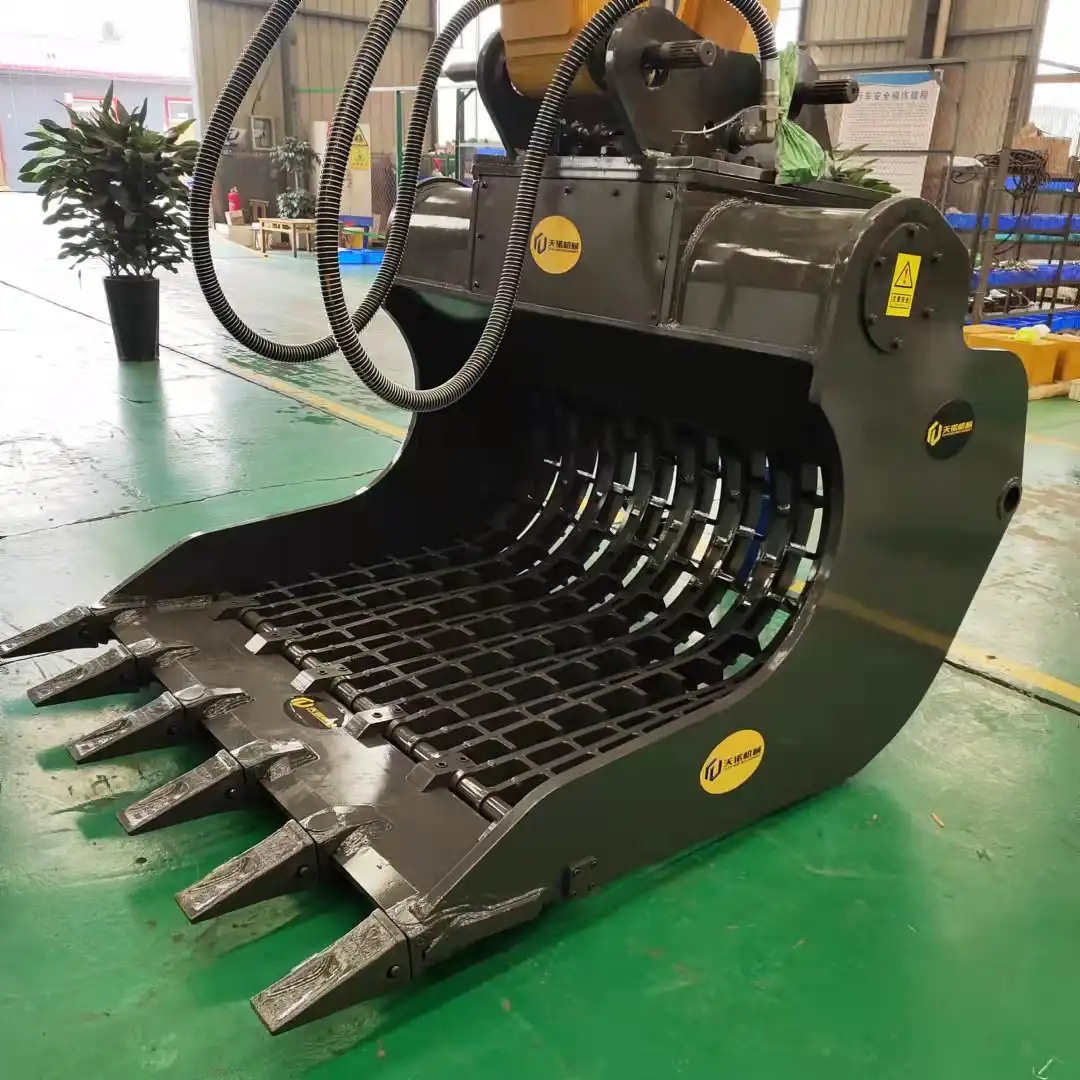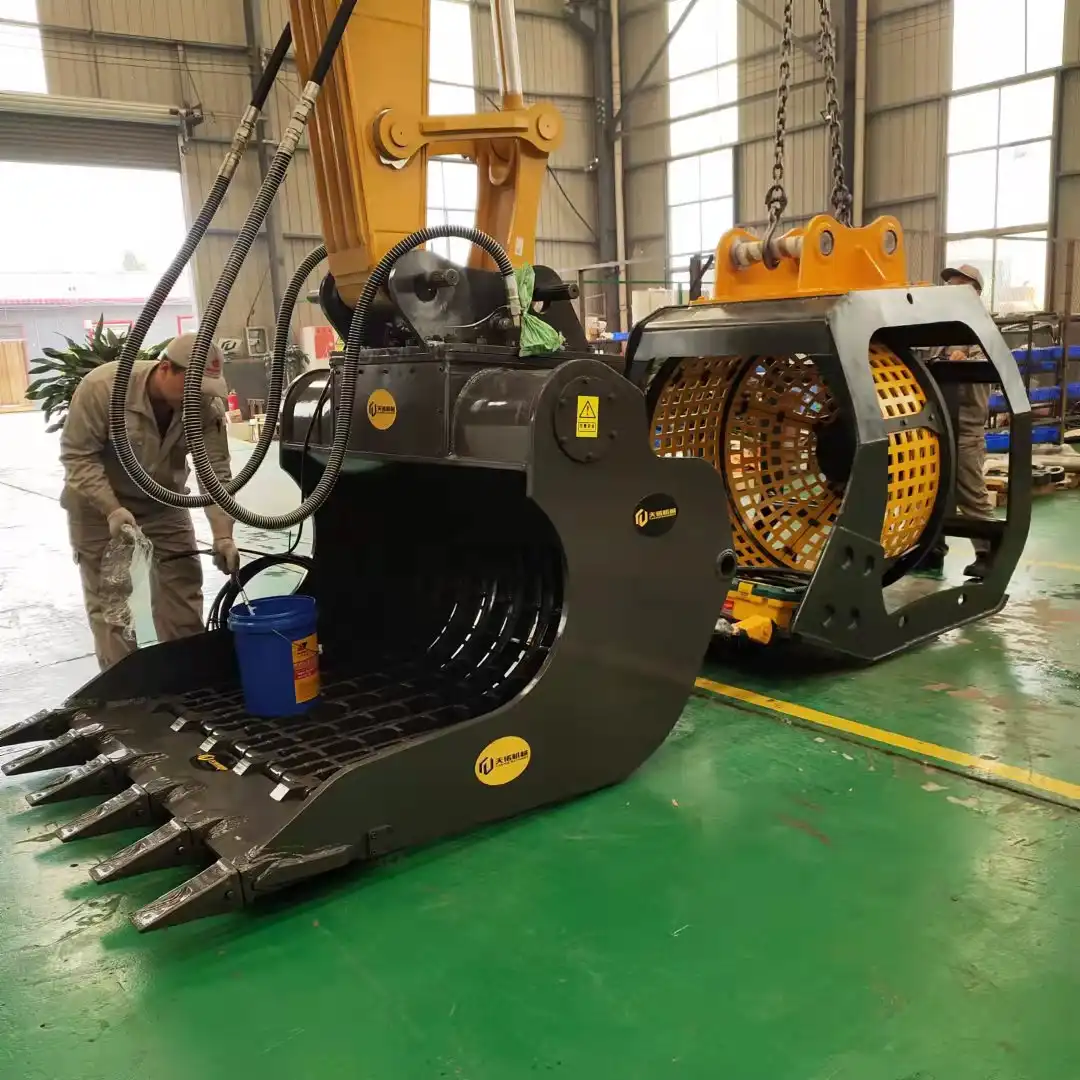Hydraulic Screening Bucket Types
When it comes to construction, excavation, and material processing, efficiency and versatility are paramount. Among the many innovations that have revolutionized these industries, the excavator screening bucket stands out as a game-changer. These remarkable attachments transform standard excavators into powerful screening machines, allowing operators to separate, filter, and process materials directly on-site without the need for additional equipment.
Hydraulic screening buckets come in various types, each designed to handle specific applications and materials. Whether you're involved in construction waste management, topsoil processing, aggregate production, or landscaping, understanding the different types of hydraulic screening buckets can help you choose the right tool for your specific needs. These versatile attachments have become indispensable in modern construction and excavation projects due to their ability to increase productivity while reducing operational costs.
The primary function of a screening bucket is to separate materials based on size, effectively filtering out unwanted elements and producing clean, sorted output. By implementing these attachments, contractors can process materials on-site, eliminating the need for transportation to external processing facilities and significantly reducing project timelines and expenses.
In this comprehensive guide, we'll explore the three main types of hydraulic screening buckets: rotating screening buckets, vibrating screening buckets, and flip-screen buckets. We'll dive into their unique features, applications, advantages, and considerations to help you make an informed decision for your next project.
Rotating Screening Bucket For Excavator

Rotating screening buckets represent one of the most versatile and efficient options in the hydraulic screening bucket family. These powerful attachments utilize a rotational motion to process materials, offering exceptional performance across various applications.
How Do Rotating Screening Buckets Work?
The operating principle behind rotating screening buckets is both simple and ingenious. The bucket features a drum design with strategically positioned screening elements that rotate using hydraulic power from the excavator. As material enters the bucket, the rotation causes it to tumble and roll against the screening surface. Particles smaller than the screen mesh fall through, while larger materials remain inside the bucket for disposal or further processing.
The rotation speed is typically adjustable, allowing operators to optimize performance based on material characteristics and desired output quality. This flexibility makes rotating excavator screening bucket models particularly valuable when processing different material types on the same job site.
Applications and Materials
Rotating screening buckets excel in numerous applications:
- Topsoil processing and preparation
- River and beach restoration projects
- Construction and demolition waste recycling
- Compost and organic material screening
- Pipeline trenching and backfilling
- Quarry operations and aggregate production
These versatile attachments can effectively process various materials, including soil, sand, gravel, demolition debris, compost, and light rock. Their design allows for efficient separation even when dealing with slightly damp or sticky materials that might challenge other screening methods.
Benefits of Rotating Screening Buckets
The popularity of rotating screening buckets stems from their numerous advantages:
- High production capacity compared to static screens
- Excellent material mixing and aeration during processing
- Reduced material clogging due to continuous rotation
- Ability to handle a wide range of material moisture contents
- Lower operating costs compared to dedicated screening plants
- Exceptional versatility across multiple applications
For contractors handling diverse projects, the adaptability of rotating screening buckets makes them a smart investment that delivers consistent returns across various job sites and material types.
Vibrating Screening Bucket: High Frequency

Vibrating screening buckets represent another innovative approach to material processing, utilizing high-frequency vibration to achieve efficient separation and screening results.
Vibration Technology and Design
Unlike rotating models, vibrating excavator screening bucket designs employ powerful vibration mechanisms to separate materials. These systems typically feature eccentric weights driven by hydraulic motors that generate consistent, high-frequency vibrations throughout the bucket structure. The vibration causes materials to move across the screening surface, allowing smaller particles to pass through while larger ones travel toward the discharge area.
Modern vibrating buckets incorporate advanced features like adjustable vibration intensity, replaceable screens with various mesh sizes, and optimized flow patterns that maximize throughput while maintaining separation quality. The vibration frequencies are carefully calibrated to handle specific material types, ensuring optimal performance across applications.
Ideal Applications
Vibrating screening buckets particularly shine in these scenarios:
- Processing dry to moderately moist materials
- Precise sizing of aggregates and construction materials
- Screening large volumes of relatively uniform materials
- Projects requiring high throughput and clean separation
- Reclamation of valuable materials from waste streams
- Processing abrasive materials that might damage rotating systems
The high-frequency vibration proves especially effective when dealing with granular materials like sand, gravel, and crushed stone, delivering consistent sizing and exceptional productivity.
Performance Advantages
The vibrating design offers several distinct benefits:
- Higher throughput capacity for certain material types
- Exceptional screening accuracy and consistency
- Reduced material compaction during processing
- Lower maintenance requirements with fewer moving parts
- Ability to handle heavier and denser materials
- Energy efficiency with optimized hydraulic consumption
For operations focused on aggregate production or projects with strict material sizing requirements, vibrating screening buckets provide the precision and reliability needed to meet demanding specifications while maintaining high productivity levels.
Flip Screen Buckets

Flip screen buckets represent an innovative approach to material screening that differs significantly from both rotating and vibrating designs. These unique attachments have gained popularity for their simplicity, durability, and effectiveness in challenging environments.
Unique Operating Mechanism
The flip screen bucket employs a distinctive screening method centered around a rotating drum or basket mounted on an excavator attachment. Unlike other designs, the flip screen rotates the entire screening assembly, effectively tumbling material through a fixed screen basket. This rotation is typically achieved through a 180-degree or 360-degree motion, hence the name "flip screen."
This design creates a powerful screening action that efficiently separates materials while minimizing the risk of clogging or blinding that can plague other screening methods. The excavator screening bucket with flip technology provides exceptional performance, particularly when processing difficult materials that tend to stick together or contain high moisture content.
Specialized Applications
Flip screen buckets excel in several challenging scenarios:
- Processing sticky or clay-rich soils
- Screening materials with high moisture content
- Separating roots and organic debris from soil
- Recovering valuable materials from mixed waste streams
- Processing materials with irregular shapes and sizes
- Operations in confined spaces with limited room for conventional screening
The ability to handle problematic materials makes flip screen buckets particularly valuable in regions with challenging soil conditions or during wet seasons when other screening methods might struggle.
Key Benefits and Considerations
Flip screen buckets offer several advantages that make them appealing for specific applications:
- Superior performance with difficult, sticky materials
- Reduced screen blinding and clogging
- Lower maintenance requirements with simplified design
- Excellent durability under harsh operating conditions
- Effective processing of materials with varying moisture content
- Simplified operation requiring less operator skill
While flip screen buckets may not match the throughput capacity of some rotating or vibrating designs for certain materials, their reliability and effectiveness with challenging materials make them invaluable in situations where other screening methods fail to perform.
FAQ
①What materials can be processed with hydraulic screening buckets?
Hydraulic screening buckets can effectively process a wide range of materials, including soil, sand, gravel, crushed stone, construction and demolition waste, compost, wood chips, and even some types of industrial waste. The specific material compatibility depends on the bucket type, screen size, and design features.
②How do I choose the right screen size for my application?
Screen size selection depends primarily on your desired end product size. Common mesh sizes range from 20mm to 100mm, with smaller openings producing finer material. Consider both your input material characteristics and output requirements when selecting screen size. Most manufacturers offer interchangeable screens to provide flexibility.
③What maintenance is required for excavator screening buckets?
Regular maintenance includes inspecting and cleaning screens, checking hydraulic connections for leaks, lubricating moving parts according to manufacturer specifications, and examining structural components for wear or damage. The specific maintenance schedule depends on operating conditions and material types being processed.
④Can excavator screening buckets process wet materials?
Yes, but with varying effectiveness depending on the bucket type. Rotating and flip screen designs generally handle moist materials better than vibrating models. Extremely wet or muddy materials may require pre-drying or specialized screen configurations for optimal results.
⑤What size excavator is required for screening buckets?
Screening buckets are available for excavators ranging from 1.5 tons to 45+ tons. The appropriate match depends on the bucket's size, weight, and hydraulic requirements. Always verify compatibility with your specific excavator model before purchase.
Hydraulic Screening Bucket Manufacturer

Hydraulic screening buckets have revolutionized material processing in construction, demolition, landscaping, and recycling operations. By understanding the distinct characteristics of rotating, vibrating, and flip screen designs, contractors and project managers can select the optimal tool for their specific applications and material types.
These versatile attachments not only increase productivity and reduce operational costs but also contribute to more sustainable construction practices by enabling on-site material processing and reuse. The right excavator screening bucket can transform your excavator from a simple digging machine into a comprehensive material processing solution.
For high-quality hydraulic screening buckets manufactured with premium materials and designed for exceptional performance across applications, consider Tiannuo Machinery's range of excavator attachments. With customizable options and robust construction using high-strength steel, our screening buckets deliver reliable performance in the most demanding environments.
To learn more about our screening bucket options, specifications, and customization possibilities, contact our team today at boom@stnd-machinery.com.
References
- Construction Equipment Guide (2023). "Advanced Screening Technologies in Modern Construction."
- Journal of Construction Engineering (2024). "On-Site Material Processing: Efficiency and Environmental Benefits."
- Heavy Equipment Review (2024). "Hydraulic Attachments Revolutionizing Excavation Projects."
- International Association of Demolition Contractors (2023). "Material Recycling Techniques in Demolition Projects."
- Equipment World Magazine (2024). "Innovations in Excavator Attachments: Productivity Enhancement Studies."
About Author: Arm
Arm is a leading expert in the field of specialized construction and railway maintenance equipment, working at Tiannuo Company.

